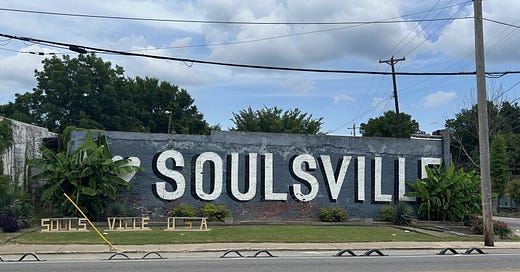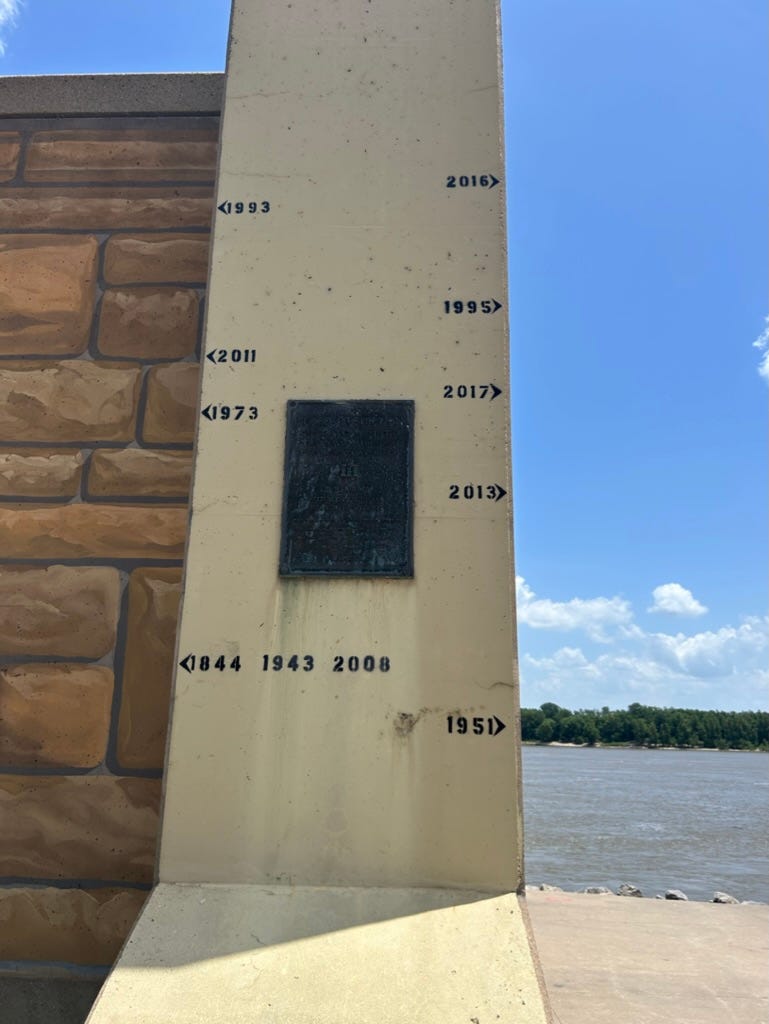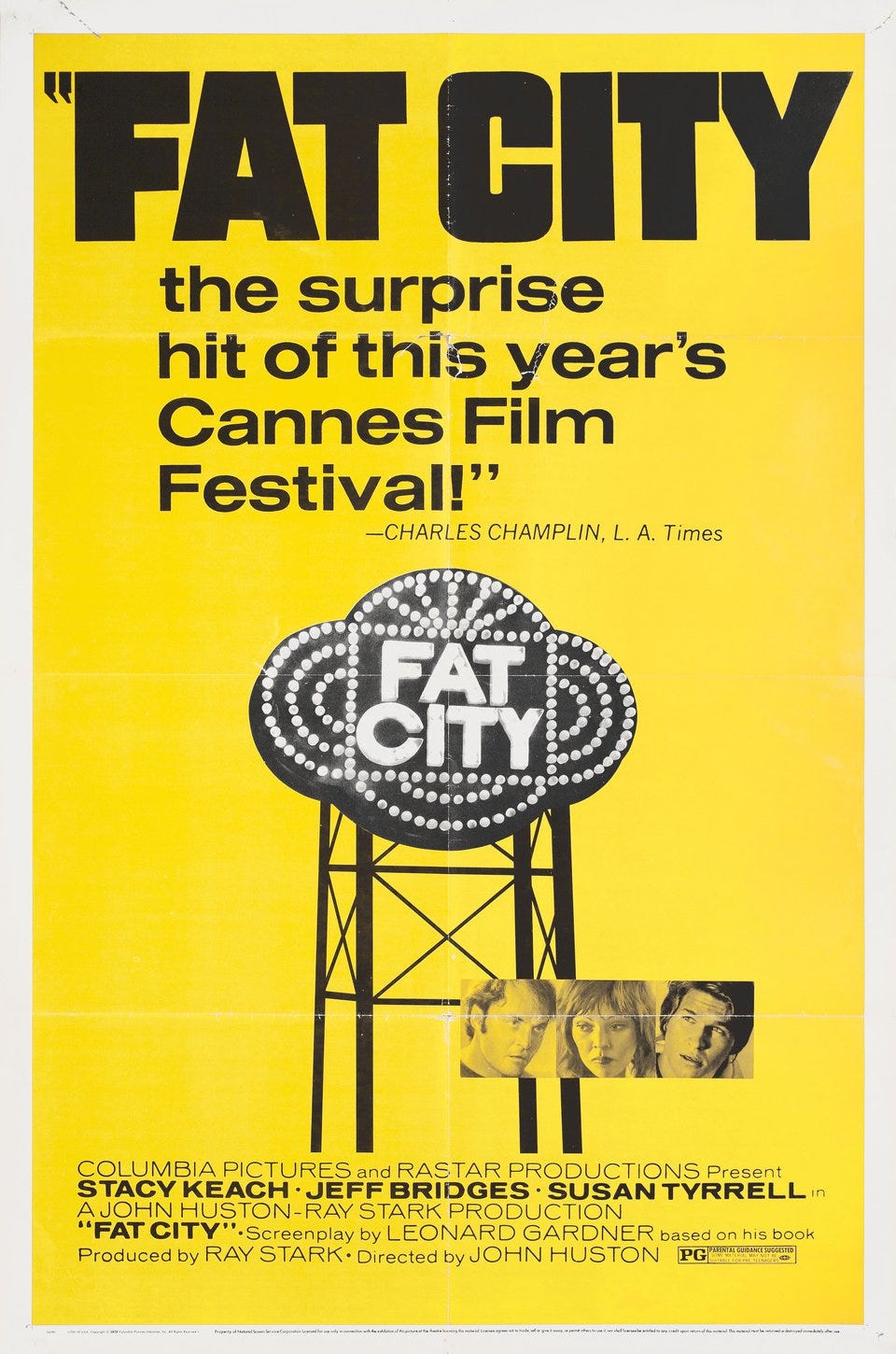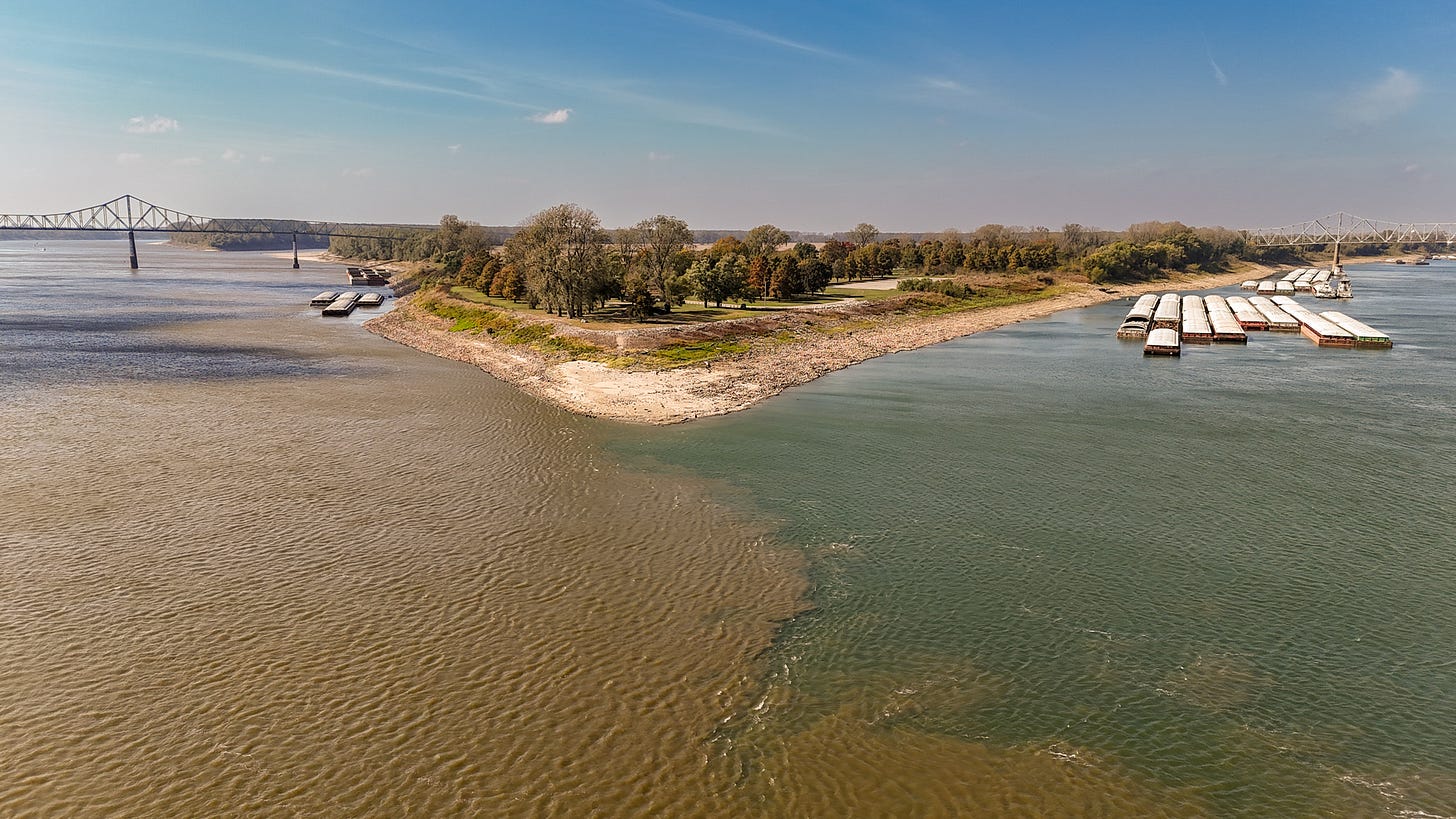The blues is a mighty long road. Or it could be a river, one that twists and turns and flows into a sea of limitless musical potential.
-Billy Gibbons
I’m reporting this today from Memphis. I pulled in yesterday and earned it. North of Memphis, with the banks of Arkansas on my right and Tennessee on my left narrowing to a half mile width, the river races through Old Brandywine Chute. A steady southwind blowing in my face made each stroke count.
I covered 214 miles since last week, from St. Genevieve, Missouri, to Soulsville, Memphis, Tennessee:
From St. Genevieve, it took me two days to get to Cape Girardeau, Missouri, a historic town.
In November 1803, Lewis and Clark arrived in Cape Girardeau, a trading post established in 1795 by Louis Lorimier, the Spanish-appointed Commandant of Cape Girardeau District. They later journeyed up the Mississippi River that I just came down on their way to the Missouri River, just north of St. Louis.
Until the Civil War, Cape Girardeau thrived as the river fort for the district. It shipped out furs, pork and beef products, cotton, grain, and lumber. It brought in furniture, dry goods, hardware, tools, and entertainment by the riverboats. During the Civil War, the town became a fortified and occupied community. Newly appointed Brigadier General Ulysses S. Grant landed here before going downriver to battle in Vicksburg, Mississippi.
Today, Cape Girardeau is located in front of a large levee wall that protects it from the high waters of the Mississippi River. Here’s a picture of water levels from previous flood years. You can see in the background the level of the river when I passed through:
Cape Girardeau is also a town of many murals. Facing the river is this iconic mural:
From the Downtown side of the levee, there is a long mural depicting the Missouri Wall of Fame. It includes a mural of Oscar-winning actor and film director John Huston, born in Nevada, Missouri.
He directed the classic films The Maltese Falcon, The African Queen, and The Treasure of the Sierra Madre. He also wrote the screenplays for most of his 37 films. Perhaps my favorite was one of his later films Fat City in 1972:
I wrote about the Burt Bacharach song The Look of Love, which appears in two films that Huston directed, Fat City and his earlier Casino Royale:
The next day I made it to Cairo, Illinois, at the confluence of the Mississippi River and the Ohio River, one of the largest confluences in the world. Here’s a good picture showing the line where these two mighty rivers meet, similar to the one I noticed at the Missouri River and Mississippi River:
I pulled up to the landing and walked around Fort Defiance, where Lewis and Clark also camped in November 1803.
As I look back now, the Mississippi River is three rivers. Although it is all one river, the three parts are each distinctive from the others.
Rising from 1475 feet at the source in Lake Itasca in Minnesota, the river flows shallowly in a rambling fashion for more than 700 miles in a broad old valley to Minneapolis and St. Paul. The hills are low and stand well back.
The second part of the river from St. Paul to Cairo, Illinois, is a canyon river, flowing between chiseled cliffs 200 to 300 feet high, as we saw last week at Grafton, or rounded hills with a valley about four miles wide.
After Cairo, I entered the third part, where the rocky cliffs end. Now the river becomes a tremendously broad, powerful, and ponderous stream slinking its way eventually to the gulf.
It’s amazing to think that Cairo was once part of the southern coastline of the American continent. Over the millennia, sea water washed the cliffs away and the soil particles carried by the water created all the land from Ohio to the Gulf of Mexico or America.
The next day, as I pulled into New Madrid ( or as they say in town, MAH-drid), there was a barge fire and black smoke billowed up into the sky. It seemed as though they were going just to let it burn. I pitched my tent by the landing and had a good night’s sleep. The next morning, I mentioned to a guy at the landing that I was surprised at the number of barges on the river. He just looked at me and said, “After St. Louis, it’s a free-for-all all.” I shoved off, and as I paddled downriver, the barge was still smoking.
Three days later, I was in Memphis, which like Cairo was named after the ancient city on the Nile. My stay here has been memorable.
Memphis was the home of the two legendary record labels, Sun Records, started by Sam Phillips in 1952, and Stax Records, started by Jim Stewart and Estelle Axton in 1957. When I got into town, my first stop was the Stax Records museum:
Stax Records was start in 1957 as the Satellite Record Company in Jim Stewart’s wife’s uncle’s garage at Orchi Street in Brunswick, Tennessee. He recorded on equipment borrowed from his barber, Erwin Ellis. From these humble beginnings, Stewart and his sister Estelle Axton built Stax Records into a multi-million dollar music business.
But before all that, Memphis was a blues city. It coined the name “the Memphis blues,” when in 1909 W. C. Handy, the "Father of the Blues," published the song The Memphis Blues. From the 1910s to the 1930s, a unique style of blues music was created by musicians in the Memphis area, such as Frank Stokes, Sleepy John Estes, Furry Lewis, Memphis Minnie, and Memphis Slim.
I first came across the name Memphis Slim while thumbing through the blues collection at the White Bear Lake Public Library and found this album:
Interestingly, I’d get to see Memphis Slim perform in Berlin twenty years later. I liked the name, “Memphis Slim ” and the red cover, so I checked it out. The last three tracks on side 1 are Kansas City No.1, 2, and 3. On the first track, Kansas City 1, I heard the name Jim Jackson for the first time.
I love how he starts the song out:
You know there is all kind a tunes made about different cities. But the one I like best is a song about Kansas City. The first I remember hear was a Kansas City by Jim jackson.
I see now that Beale Street, which he was talking about, was in Memphis. For the longest time, I thought Beale Street was in Kansas City. Today, Beale Street is still alive with great music.
Jim Jackson was born in Mississippi. He was raised on a farm, where he learned to play guitar. Around 1905, he played at dances and parties and started working as a singer, dancer, and musician in medicine shows. He soon began traveling with the Rabbit Foot Minstrels, featuring Ma Rainey, Bessie Smith, and B. B. King.
He then settled down in Memphis and played in clubs on Beale Street. His popularity and skill landed him a residency at the prestigious Peabody Hotel in Memphis in 1919.
In 1929, he recorded I’m Wild About My Lovin for the Victor label:
Here is Jackson performing the song:
The blues is one of the pillars of almost all modern, popular music. When you hear it, you associate it with the United States. That blues sound comes off hundreds of thousands of men plowing behind mules. If you have a twenty acre field and you’re plowing with a mule, you walk every step of that field. So the tempo of the music is in there. It’s earth music.
In the end, the blues is about living in harmony with the earth.
In Memphis, of course, I find myself whistling Hoagy Charmichael’s Memphis in June:
It doesn’t get much better than being in Memphis in June.
It’s hard to say where I’ll be next week on this big river. But it will be my last post from the river. So let’s see where it gets me…
Your true pilot cares nothing about anything on earth but the river, and his pride in his occupation surpasses the pride of kings.
-Mark Twain
Please hit this link to buy me a cup of coffee, if you’d like to show your guide some appreciation for this and past journeys. Know in advance that I thank you for your kindness and support.
If you like what you’ve been reading and hearing so far on our journey and would like to share this with someone you think might be interested in learning more about our great American art form, Jazz, just hit the “Share” button.
From Astaire to Sun Ra: A Jazz Journey is a reader-supported publication. If you feel so inclined, subscribe to my journey by hitting the “Subscribe now” button.
Feel free to contact me at any time to talk shop. I welcome and encourage that.
Until then, keep on walking….














So Loved your photos in Cape. Loved the journey. What you said about the river being three is so true. Last year, I had the chance to be at Lake Itasca, MN, Le Claire, Iowa-Quad Cities, Memphis and then Tunica, MS, and Pittsburgh where the Ohio starts its journey. So your description was so reflective of what I saw.
Thanks for the update - after leaving the Army, my small family settled in Memphis for 5 years, living a block south of Union Avenue downtown. We were three at the time, become 4 when my youngest daughter Katie was born in Memphis. When we moved back to my hometown of Santa Fe, Katie was talking and had the cutest southern drawl, saying things like "five" and "mine" in the midsouth accent. June is truly the best month in Memphis, but football season (I was coaching back then) meant hot summer practices and two-a-days in the August Memphis heat....
Be safe as you meander down to NOLA!